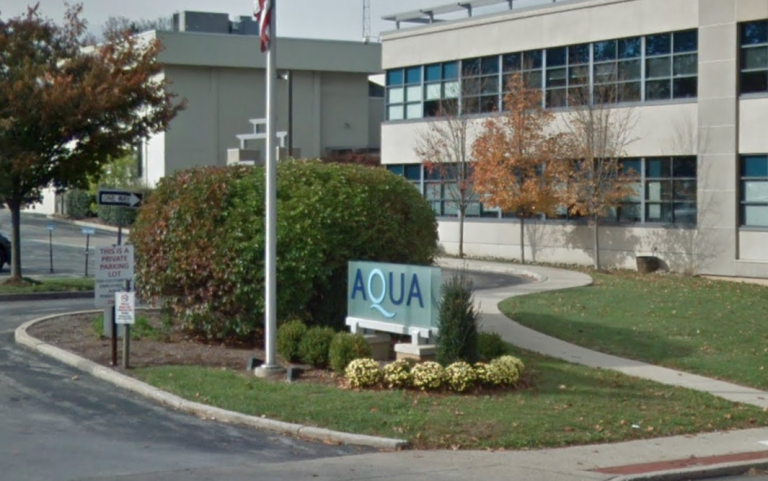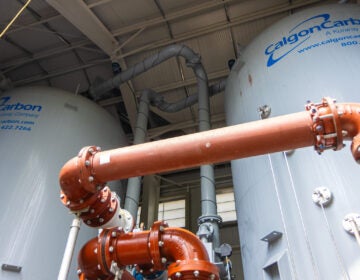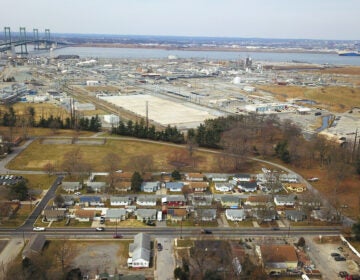PFAS chemicals showing up in Montco water beyond military bases
Aqua has taken two wells offline due to elevated levels of potentially harmful chemicals.
Listen 1:50
Aqua Pennsylvania offices in Bryn Mawr, Pa. (Google maps)
For years, communities near former military bases in Bucks and Montgomery counties have been battling tainted groundwater due to a class of chemicals called PFAS, which are found in the firefighting foam that was used on the bases.
Now, those chemicals also are showing up in other water sources in the region.
In the past month, Aqua Pennsylvania has taken two of its wells in Montgomery County offline due to elevated levels of PFAS, which have been connected to liver damage, high cholesterol, and, potentially, cancer.
The PFAS levels in Upper Dublin and North Hills were both far below the levels detected in Warminster, Horsham, and Willow Grove, where the military bases were located, and also below the federal standard of 70 parts per trillion.
But a June report from the Centers for Disease Control and Prevention suggested that standard was seven to 10 times too high.
“Nobody knows what to make of the numbers, quite frankly,” said Abington Commissioner Mike Thompson, who represents the township’s North Hills section.
He and fellow North Hills residents started noticing elevated PFAS levels of 40-50 parts per trillion earlier this summer on Aqua’s monitoring web site, WaterFacts.com. But since the levels were below the EPA’s standard and above what the CDC now recommends, people had a lot of questions.
“It’s just been a confusing mess of, ‘Is the water safe?’ and ‘What should I do?’ ” Thompson said. “And getting guidance from federal officials has been a bit of a challenge.”
Aqua, which serves about 107,600 customers in Montgomery County and 362,200 in Southeastern Pennsylvania, met with concerned residents over the summer and ultimately took both the North Hills and Upper Dublin wells offline.
Like the concerned residents, officials from Aqua said they have also been frustrated by a lack of answers from regulators.
“There’s no clear direction from EPA or our state regulator as to what levels should be provided and treated for,” said Christopher Crockett, Aqua’s chief environmental officer. “We’ve decided to move ahead with our own plan.”
Aqua isn’t the only utility dealing with PFAS contamination. Suppliers in the region ranging from North Wales Water Authority to North Penn Water Authority have all found detectable levels of PFAS in their water, as have municipalities across the country.
The issue is distinguishing between what is detectable and what is harmful, and that question still hasn’t been answered.
“The ability to detect the chemical and our ability to understand the significance from a public health point of view are not at the same pace,” said Crockett.
It also isn’t entirely clear where the chemicals are coming from. In places near the former military bases, most of the contamination has been attributed to firefighting foam used at the installations. In other locations, the contamination might be due to a firefighting facility or a past accident.
“There’s a variety of different sources out there beyond military bases that we have to look at as well,” said Crockett.
Aqua is installing a filtration system in the North Hills and Upper Dublin wells, as it did in Chalfont and Hatboro in 2016 when those wells were taken offline for PFAS contamination. The cost of a new filtration system varies, but it can range from $750,000 to $1 million just to build and install. Those costs are projected future costs and are not related to the recent rate hike Aqua announced.
The Upper Dublin well should be back online in about six months, but the North Hills well will be out of service longer due to its smaller footprint, which makes installing a new system more complex. In the meantime, both areas are getting water from the nearby Abington well.
WHYY is your source for fact-based, in-depth journalism and information. As a nonprofit organization, we rely on financial support from readers like you. Please give today.





